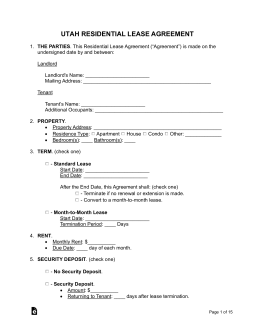Updated February 22, 2024
A Utah lease agreement is a legally binding document used by a landlord to rent property to a tenant. The agreement will establish the responsibilities and terms for each party to adhere to. Prior to authorizing a lease, it is recommended that the landlord run a credit report to verify the tenant’s credit and income
Table of Contents |
Agreement Types (7)
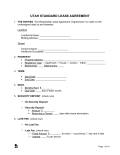 Standard Residential Lease Agreement – Residential contract with a start and end date. Usually one year and the most commonly used rental form. Standard Residential Lease Agreement – Residential contract with a start and end date. Usually one year and the most commonly used rental form.
Download: PDF, MS Word, OpenDocument |
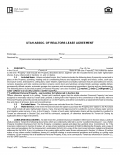 Association of Realtors – Official form for use by licensed realtors when handling transactions between landlords and tenants. Association of Realtors – Official form for use by licensed realtors when handling transactions between landlords and tenants.
Download: PDF |
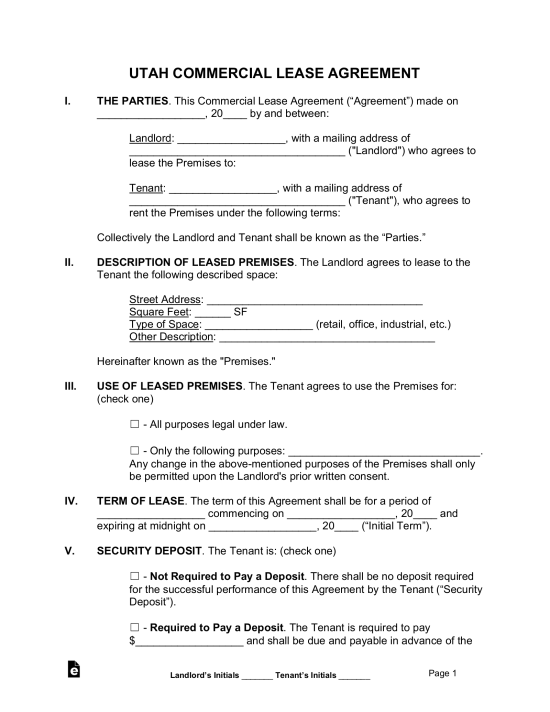 Commercial Lease Agreement – For industrial, retail, or office type of space that is not livable. Commercial Lease Agreement – For industrial, retail, or office type of space that is not livable.
Download: PDF, MS Word, OpenDocument |
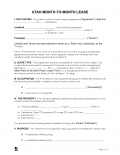 Month-to-Month Lease Agreement – State law allows a tenancy at will to be terminated with 15 days’ notice by either landlord or tenant. Month-to-Month Lease Agreement – State law allows a tenancy at will to be terminated with 15 days’ notice by either landlord or tenant.
Download: PDF, MS Word, OpenDocument |
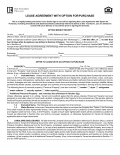 Rent-to-Own Lease Agreement – For the use of standard tenancies along with the added option of being able to buy the property in accordance with the terms agreed to by both parties. Rent-to-Own Lease Agreement – For the use of standard tenancies along with the added option of being able to buy the property in accordance with the terms agreed to by both parties.
Download: PDF, MS Word, OpenDocument |
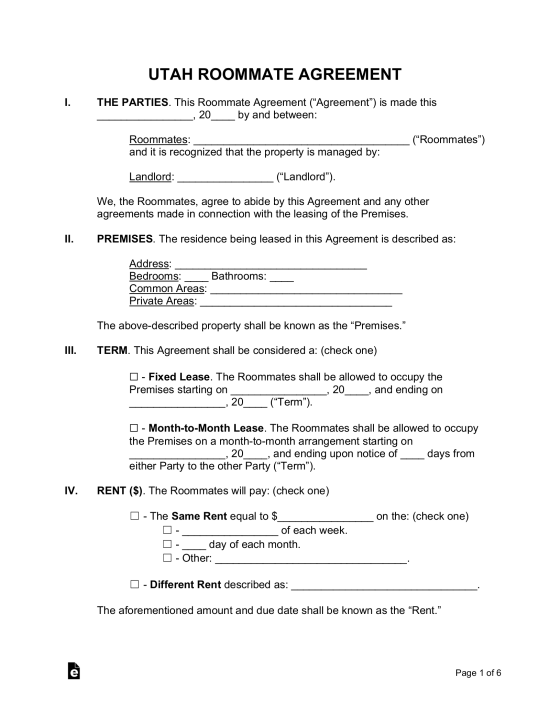 Room Rental (Roommate) Agreement – Used as a means for individuals sharing a home to establish guidelines and rules for the common areas and how much each must pay for certain expenses. Room Rental (Roommate) Agreement – Used as a means for individuals sharing a home to establish guidelines and rules for the common areas and how much each must pay for certain expenses.
Download: PDF, MS Word, OpenDocument |
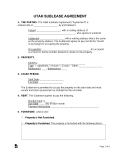 Sublease Agreement – Allows a tenant under a standard lease to rent the same premises, known as a ‘sublet’, to someone else, known as the “subtenant,” until the end of their lease term. This type of tenancy must usually be approved by the landlord. Sublease Agreement – Allows a tenant under a standard lease to rent the same premises, known as a ‘sublet’, to someone else, known as the “subtenant,” until the end of their lease term. This type of tenancy must usually be approved by the landlord.
Download: PDF, MS Word, OpenDocument |
Required Disclosures (4)
- Lead-Based Paint Disclosure – Federal law requires that the owner, landlord, or manager of a residential unit built before 1978 inform any new tenants of the possibility of lead paint in the walls and ceilings.
- Rent Disclosure – Before accepting any payment from a prospective tenant, the landlord must disclose in writing the estimated rent amount, the date that the unit will be available, any eligibility criteria, and how to recover application fees.[1]
- Owner/Manager Information – At or before the start of tenancy, the landlord must provide the tenant with the name, address, and phone number of the owner of the property and of any individual authorized to act on the owner’s behalf.[2]
- Lease Copy – The landlord must provide the tenant with an executed copy of the lease agreement, as well as a copy of any rules and regulations governing the use of the rental unit.[3]
Security Deposits
Maximum Amount – There is no maximum amount that a landlord can request for a security deposit in the state of Utah.
Collecting Interest – Utah state law does not require a landlord to collect or pay interest on a tenant’s security deposit.
Returning – The landlord must return the balance of the security deposit and any prepaid rent back to the tenant within 30 days of the end of tenancy.[4]
- Itemized List – If part of the security deposit is used to cover unpaid rent or the costs of damages to the unit, the landlord must provide the tenant with an itemized list explaining these applications within 30 days of the end of tenancy.[5]
When is Rent Due?
Grace Period – There is no statutory grace period for the late payment of rate in Utah. If the tenant does not pay rent on the due date established in the lease agreement, the landlord can send a three-day notice to quit.[6]
Maximum Late Fee – The landlord cannot charge a late fee that is more than $75 or 10% of the monthly rent, whichever is greater.[7]
NSF Fee – $20 is the maximum amount that a landlord can charge for a bad check.[8]
Withholding Rent – If the landlord, after receiving written notice, fails to remedy a deficient condition in the unit, the tenant may correct the condition on their own and deduct up to two month’s rent from their future rent payments.[9]
Right to Enter (Landlord)
Standard Access – Unless otherwise agreed upon in the lease agreement, the landlord must give at least 24 hours’ notice before entering the rental property.[10]
Immediate Access – Utah state law does not specify when a landlord may gain immediate entry into a rental unit. If the landlord wishes to retain the right to enter without notice during an emergency, this should be stated in the lease agreement.
Abandonment
Absence – If the tenant is absent from the premises without notice, and they are at least 15 days late in paying rent, then the unit may be presumed to be abandoned.[11]
Breaking the Lease – A tenant may terminate a lease early if they are a victim of domestic violence[12] or if, after having given the landlord notice of a deficient condition in the unit, the landlord has failed to take action toward remedying the condition.[13]
Tenant’s Utility Shutoff – If the tenant fails to maintain utilities on the property in violation of the terms of the lease agreement, then the landlord may serve a three-day notice to quit the premises or remedy the violation.[14]
Unclaimed Property – The landlord must store any personal property left behind by the tenant, with certain exceptions, for at least 15 days, during which time the tenant may recover the property by paying the costs of removal and storage.[15]

